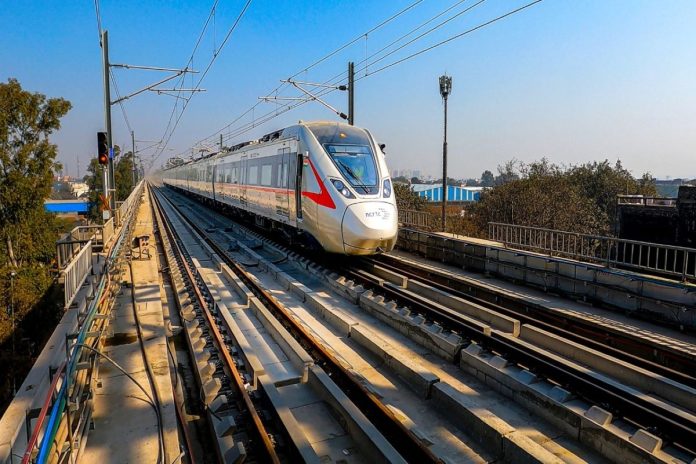More than twenty years ago, on 24 December 2002, the then prime minister, Atal Bihari Vajpayee, inaugurated the first section of the Delhi Metro.
The Red Line of the Delhi Metro was opened up for commuters the following day, connecting Shahdara and Tis Hazari, two densely populated areas in the national capital, and while encompassing merely six stations.
Today, with 288 stations, a network length of almost 400 kilometres and across twelve lines, the Delhi Metro moves the economy of the national capital region (NCR).
On 20 October, 2023, history shall be repeated.
However, this time, the scale would be much higher, proportionally, with far-greater economic consequences for NCR.
While only the priority section of the Delhi-Meerut Regional Rapid Transit System (RRTS) will be inaugurated by Prime Minister Narendra Modi, covering five stations across 17 kilometres, it will set the ball rolling for commencement of the other sections in the coming months, and consequently, other routes in the coming years, quite like how Delhi Metro grew.
One small step towards connectivity, one giant leap towards urbanisation.
The area of coverage under RRTS or Namo Bharat will be far greater than that of the Metro.
The RRTS’ first route will include Delhi-Meerut, followed by Delhi-Alwar and Delhi-Panipat. The second phase of RRTS, aimed for completion in early next decade, has five other routes under planning. These include Delhi-Palwal, Delhi-Khurja, Delhi-Rohtak, Delhi-Baraut, and Ghaziabad-Hapur.
In the first phase itself (Meerut, Panipat, and Alwar), the RRTS will be able to cover an area of more than 8,000 square kilometres.
Add the second phase, and the total area covered will be in excess of 25,000 square kilometres. In comparison, the Delhi Metro covers not more than 3,500 square kilometres, at its current capacity, after twenty years in operation.
However, the Namo Bharat infrastructural undertaking must not be perceived as a connectivity project alone, for it will have consequences beyond transportation.
For starters, it will be instrumental in decongesting the national capital.
For the ones who may live in distant areas, across the three states of Uttar Pradesh, Haryana, and Rajasthan, the RRTS will ease access to the far-flung places in the national capital where they may want to consider employment.
Thus, for the population of these towns and villages, the RRTS will also double-up as an enabler, especially for women, allowing them easy access to the cities, and consequently, more professional opportunities.
It is no secret that the cities like Delhi, Mumbai, and Bengaluru are under tremendous stress in terms of natural resources, and much of it has to do with the incoming workers from other areas.
To decongest a city, it is necessary to expand the suburbs and their connectivity to the main economic hub, in this case Delhi, which makes the RRTS the most important urban infrastructure project of the decade.
The economic consequences of the RRTS, in the years to come, would be several. To begin with, it should cool off the inflated real estate sector in NCR, as more and more people opt for the suburbs, given the rising air pollution, water scarcity, traffic woes, along with other issues that have now become a routine in NCR rather than an exception.
For the area falling under the coverage of RRTS, the local bodies, aided by their respective state governments, must sense an opportunity, in both real and commercial estate, special economic zones for industries, and tourist hubs.
For instance, Murthal in Haryana, planned as one of the RRTS stations in the future, can be an important tourist destination, given the number of people it attracts each day due to its proximity to Delhi and the famous food joints.
It is also important that National Capital Region Transportation Corporation (NCRTC) focusses on monetisation of RRTS, quite like the Delhi Metro. From stations to the coaches of the train, also known as RAPIDX, everything can be monetised to boost the revenues.
More than a mere transportation PSU, both Delhi Metro Rail Corporation (DMRC) and NCRTC, must be perceived as real estate companies. The key stations on the route must double-up as small to medium-sized shopping and eating hubs.
Private sector contracts for advertising on pillars, coaches, and inside the train must be tendered as well on regular intervals.
In this day and age, there is no dearth of permutations that can be applied when it comes to monetising real estate space, and the NCRTC must leave no stone unturned in maximising their revenues.
The Mumbai Local, as it is fondly known, moves a city, while the Delhi Metro is hailed for facilitating travel across Delhi to Ghaziabad, Faridabad, Noida, and Gurugram and Greater Noida to some extent.
However, RRTS is at least ten times bigger than any of these existing systems, on paper. In practice, the numbers it will clock in the coming years will be a testament to its economic and urban utility. For now, it is still very early days for the RRTS.
Finally, RRTS will also change how governments (centre and state), and policymakers look at urbanisation.
Instead of jam-packed cities, with densely populated regions, and several routine problems, RRTS, as an idea, must usher expanded suburbs encompassing towns and smaller cities, and focus on retaining the key economic hubs as work destinations for people, and not a settling choice. This is good for the economy, environment, and expansion of urban areas.
Perhaps, today is the day when the governments in Mumbai and Bengaluru, to begin with, start pondering over the idea of a regional rapid transit system, factoring in the needs of the ten trillion dollar economy we are going to be in the coming years.


